

Adipose lipid turnover and long-term changes in body weight. Fat is more than calorie storage. A group of researchers based at the Joslin Diabetes Center and Harvard Medical School just published a paper in the journal Nature Metabolism that tells us something new and amazing, as well as confirms something we all know already.
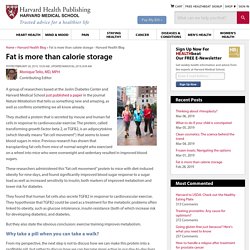
They studied a protein that is secreted by mouse and human fat cells in response to cardiovascular exercise. The protein, called transforming growth factor-beta 2, or TGFB2, is an adipocytokine (which literally means “fat cell movement”) that seems to lower blood sugars in mice. Previous research has shown that transplanting fat cells from mice of normal weight who exercised on a wheel into mice who were overweight and sedentary resulted in improved blood sugars. These researchers administered this “fat cell movement” protein to mice with diet-induced obesity for nine days, and found significantly improved blood sugar response to a sugar load as well as increased sensitivity to insulin, both markers of improved metabolism and lower risk for diabetes.
Exploring the consumption of ultra-processed foods and its association with food addiction in overweight children. - PubMed - NCBI. Weight Loss After 40: The Difficulties. Microbes, Not Food Restriction, Could Be The Key to Our Most Effective Treatment For Obesity. Obesity - Search: The Coca-Cola Company. Loading...

The Company (NYSE: KO) is the world’s largest beverage company, offering over 500 brands to people in more than 200 countries. Of our 21 billion-dollar brands, 19 are available in lower- or no-sugar options to help people moderate their consumption of added sugar. In addition to our namesake drinks, some of our leading brands around the world include: AdeS soy-based beverages, Ayataka green tea, Dasani waters, Del Valle juices and nectars, Fanta, Georgia coffee, Gold Peak teas and coffees, Honest Tea, Minute Maid juices, Powerade sports drinks, Simply juices, smartwater, Sprite, vitaminwater, and Zico coconut water. Food and Beverage Companies Commit to Health of Mexicans: The Coca-Cola Company. Coca-Cola and 11 other leading food and nonalcoholic beverage companies recently reaffirmed their support of Mexico’s National Strategy for the Prevention and Control of Obesity by signing a pledge witnessed by Secretary of Health Dr.
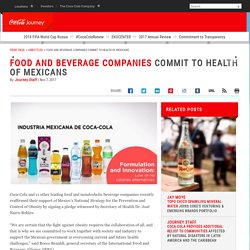
José Narro Robles. “We are certain that the fight against obesity requires the collaboration of all, and that is why we are committed to work together with society and industry to support the Mexican government in overcoming current and future health challenges,” said Rocco Renaldi, general secretary of the International Food and Beverage Alliance (IFBA). The letter signed by leaders from , Ferrero, General Mills, Bimbo Group, Peñafiel Group, Kellogg, Mars, McDonald's, Mondelez International, Nestlé, PepsiCo and Unilever, focuses on four fundamental areas: formulation and innovation; clear information for consumers; responsible advertising practices focused on children; and promotion of healthy lifestyles. How one of the most obese countries on earth took on the soda giants. Mexicans love their soda.

Construction workers go to their jobs in the early morning clutching giant two-litre or even three-litre bottles. Babies in strollers suck on bottles filled with orange soda. In the highlands of Chiapas, Coca-Cola is considered to have magical powers and is used in religious rites. Obesity and the Economics of Prevention - Fit not Fat - en. Before 1980, rates were generally well below 10%.
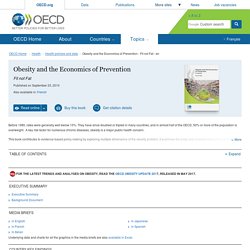
They have since doubled or tripled in many countries, and in almost half of the OECD, 50% or more of the population is overweight. A key risk factor for numerous chronic diseases, obesity is a major public health concern. This book contributes to evidence-based policy making by exploring multiple dimensions of the obesity problem. PHE data and analysis tools. UK obesity data data for the adult population 20. Flipping the Metabolic Switch: Understanding and Applying the Health Benefits of Fasting - Anton - 2018 - Obesity.
Being “fat and fit” is a myth, study says - West Island Blog. By Richard Tardif Big is beautiful, fat but fit, big-boned, healthy at any size – all of them are big fat myths, says a study, recommending people should aim to maintain a body weight within a healthy range, or die early.

“The research shows that those overweight individuals who appear to be otherwise healthy are still at increased risk of heart disease,” says lead author Dr. Studies reveal long-term effects of gastric bypass surgery in severely obese teenagers. American Society for Metabolic and Bariatric Surgery. Insulin resistance cause found, reversed in animal study.
UC San Diego scientists say they've discovered a cause of insulin resistance — a hallmark of type 2 diabetes — and reversed it in mice.
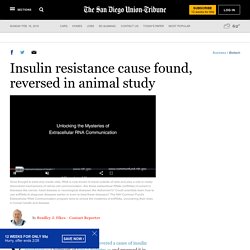
If the study is confirmed in people, it will answer a longstanding question about how insulin resistance arises. The research also has implications for therapy and diagnosis of type 2 diabetes, a major health problem. The study found that immune cells in fat tissue emit messaging molecules that control the process. Artificial sweeteners may increase risk of type two diabetes, finds study. Consuming artificial sweeteners might raise the risk of developing type two diabetes, new research suggests.

The study was conducted by professors at the University of Adelaide in Australia and looked at whether ingesting significant amounts of artificial sweeteners would affect the body’s ability to control glucose levels in the blood. They recruited 27 healthy participants and gave some of them capsules containing artificial sweeteners, an amount equivalent to five cans of diet drinks. The capsules contained sucralose and acesulfame K and had to be taken three times a day for two weeks. The others took placebo capsules. Being fat and fit is actually impossible: study. THE body positive movement’s mantra — “healthy comes in many sizes” — is being challenged by a groundbreaking new study.
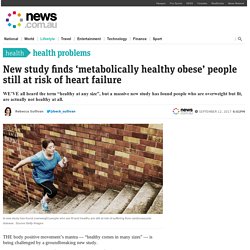
Researchers at University of Birmingham’s Institute of Applied Health Research looked at public health records of 3.5 million Brits over a 20-year period, and compared weight and metabolic status to the risk cardiovascular disease. The results were published this week in the Journal of the American College of Cardiology. People who are “metabolically healthy obese” — those who are obese but not suffer from conditions such as diabetes, high blood pressure and high cholesterol — still have an increased risk of cardiovascular disease, compared to people who are of a “normal” weight, the study found. “Three metabolic abnormalities were taken into consideration during the study — diabetes, hypertension [high blood pressure] and hyperlipidaemia [high cholesterol]. “Sugar Awareness” Awarenesss « The Merseyside Skeptics Society. Weight reduction for primary prevention of stroke in adults with overweight or obesity - Curioni - 2006 - The Cochrane Library.
Plain language summary Weight reduction for primary prevention of stroke in adults with overweight or obesity Rigorous scientific evidence linking overweight or obesity with increased risk for stroke is missing.

Overweight and obesity are important public health problems and are associated with many serious health conditions including stroke which is a leading cause of death and severe long-term disability. It’s easy to become obese in America. These 7 charts explain why. It’s no secret that Americans have gotten much, much bigger over the past few decades. The signs are all around us, from XXXL clothing sizes to supersize movie seats and even coffins. According to an analysis from the Centers for Disease Control and Prevention, the average American man now stands at 5-feet-9 1/4 inches tall and weighs 196 pounds — up 15 pounds from 20 years ago. For women, the change has been even more striking: The average female today stands 5-feet-3 3/4 inches and weighs 169 pounds. In 1994, her scale read 152 pounds. How Miss America's winners have changed - INSIDER. Mark Makela/REUTERS The Miss America beauty pageant looks a lot different today than it did 94 years ago when it was called a "popularity contest" across nine East Coast newspapers.
But today's two-hour TV extravaganza differs from the original in another fascinating way — the winners' body types have gotten much thinner over the years, according to educational website PsychGuides.com (first spotted on the Huffington Post). PsychGuides.com tracked the evolution of the Miss America winner's body types since the contest started in 1921 using all the publicly available pictures the team could find. PsychGuides.com then made a morph to show the dramatic shift, which you can really see emerging in the fitness-obsessed 1980s. The website went further and also charted how the average American woman's body differed from Miss America's, tracking down all of the heights and weights of winners available to calculate the women's body mass indexes.
Protons for Breakfast Blog. The upper curve shows the relationship between body mass index (BMI) and mortality expressed as relative risk of death compared to those with a BMI in the range 22.5 to 25. Protons for Breakfast Blog. Calorie counting: the good, the bad and the ugly - The Real Life RD. Epigenetics: Part Two. Traces of Dutch 'Hunger Winter' in genetic material - News 2010. La anorexia y la obesidad comparten factores de riesgo. How much sugar do we eat? Image copyright Getty Images. The Inconvenient Truth about Sugar Consumption (it’s not what you think) : CEFS. 11 Graphs That Show Everything That is Wrong With The Modern Diet.
The modern diet is the main reason why people all over the world are fatter and sicker than ever before. Everywhere modern processed foods go, chronic diseases like obesity, type 2 diabetes and heart disease soon follow. The studies are clear on this... when people abandon their traditional foods in favor of modern processed foods high in sugar, refined flour and vegetable oils, they get sick (1, 2, 3).